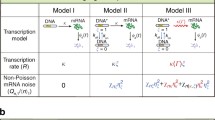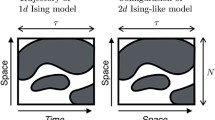Abstract
Fluctuation analysis, which is often used to demonstrate random mutagenesis in cell lines (and to estimate mutation rates), is based on the properties of a probability distribution known as the Luria-Delbrück distribution (and its generalizations). The two main new results reported in this paper are (i) a simple, completely general, and computationally efficient procedure for calculating probability distributions arising from fluctuation analysis and (ii) the formula for this procedure when cells in a colony have only grown for a finite number of generations after initial seeding. It is also shown that the procedure reduces to one that was developed earlier when an infinite number of generations is assumed. The derivation of the generating function of the distribution is also clarified. The results obtained should also be useful to experimentalists when only a relatively short time elapses between seeding and harvestint cultures for fluctuation analysis.
Similar content being viewed by others
References
ArmitageP., 1952. The statistical theory of bacterial populations subject to mutation. J. R. Statist. Soc. B14: 1–40.
ArmitageP., 1953. Statistical concepts in the theory of bacterial mutation. J. Hygeine S1: 162–184.
BartlettMS., 1978. An Introduction to Stochastic Processes. 3rd ed. Cambridge, Cambridge University Press.
HildebrandF. B., 1976. Advanced Calculus for Applications, 2nd ed. Englewood Cliffs, Prentice-Hall.
KendalW. S. & FrostP., 1988. Pitfalls and practice of Luria-Delbrück fluctuation analysis: a review. Cancer Research 48: 1060–1065.
KochA. L., 1982. Mutation and growth rates from Luria-Delbrück fluctuation tests. Mutat. Res. 95: 129–143.
LeaD. E. & CoulsonC. A., 1949. The distribution of the number of mutants in bacterial populations. J. Genetics 49: 264–285.
LuriaS.E. & DelbrückM., 1943. Mutations of bacteria from virus sensitivity to virus resistance. Genetics 28: 491–511.
Ma, W. T., Sandri, G. v. H. & Sarkar, S., 1992. Analysis of the Luria-Delbrück distribution using discrete convolution powers. Forthcoming in the Journal of Applied Probability.
SarkarS., 1991a. Haldane's solution of the Luria-Delbrück distribution. Genetics 127: 257–261.
SarkarS., 1991b. Lamarck contre Darwin, reduction versus statistics: conceptual issues in the controversy over directed mutagenesis in bacteria. In TauberA.l. (ed.) Organism and the Origin of Self. Kluwer, Dordrecht, pp. 235–271.
StewartF. M., GordonD. M. & LevinB. R., 1990. Fluctuation analysis: the probability distribution of the number of mutants under different conditions. Genetics 124: 175–185.
vonBorstelR. C., 1978. Measuring spontaneous mutation rates in yeast. Methods in Cell Biology 20: 1–24.
Author information
Authors and Affiliations
Rights and permissions
About this article
Cite this article
Sarkar, S., Ma, W.T. & Sandri, G.v.H. On fluctuation analysis: a new, simple and efficient method for computing the expected number of mutants. Genetica 85, 173–179 (1992). https://doi.org/10.1007/BF00120324
Received:
Accepted:
Issue Date:
DOI: https://doi.org/10.1007/BF00120324




